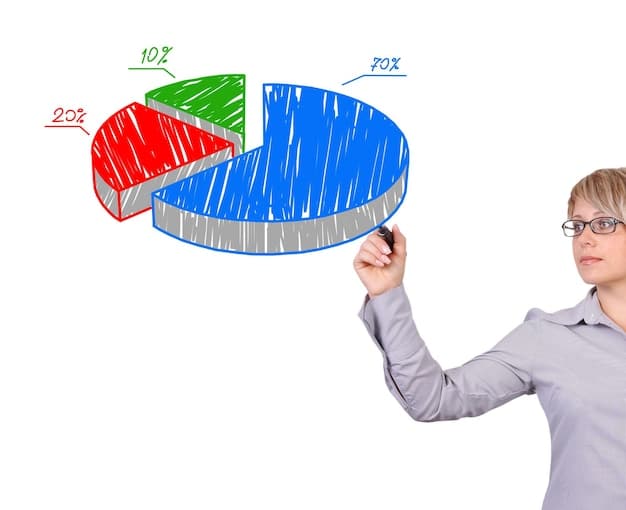Cutting Costs: Your Frugal Living Guide for 2025

Cutting Costs Without Sacrificing Quality: A Guide to Frugal Living in 2025 provides actionable strategies for reducing expenses while maintaining a high quality of life, covering budgeting techniques, mindful spending habits, and innovative ways to save money in various aspects of life.
Anúncios
Embarking on a journey toward financial well-being doesn’t mean sacrificing the things you enjoy. Our guide, Cutting Costs Without Sacrificing Quality: A Guide to Frugal Living in 2025, offers practical tips and innovative strategies to help you live a fulfilling life on a budget.
Understanding Frugal Living in 2025
Frugal living isn’t about deprivation; it’s about making conscious choices about where your money goes. In 2025, with the increasing cost of living, embracing frugality is more important than ever. It’s about being smart with your resources and prioritizing what truly matters to you.
What Frugal Living Truly Means
Many people misunderstand frugal living, associating it with extreme penny-pinching. However, the core idea is about being intentional with your money. It involves:
- Mindful Spending: Being aware of every purchase and its value.
- Prioritizing Needs: Differentiating between needs and wants.
- Finding Value: Seeking the best quality for the lowest price.
- Eliminating Waste: Reducing unnecessary expenses.
By embracing these principles, you can achieve your financial goals without feeling restricted.
Why Frugal Living is More Relevant Than Ever
In an era marked by economic uncertainty and increasing living costs, frugal living is not just a trend—it’s a necessity. Here’s why:
- Financial Security: Building a safety net for unexpected events.
- Debt Reduction: Paying off debts faster and avoiding future loans.
- Achieving Goals: Saving for major life events like buying a home or retirement.
- Reducing Stress: Gaining control over your finances reduces anxiety.
Adopting frugal habits ensures you are prepared for whatever the future holds, while still enjoying the present.
In essence, understanding frugal living in 2025 means recognizing its importance in achieving financial stability and a higher quality of life through conscious spending habits.
Budgeting Strategies for Frugal Living
Budgeting is the cornerstone of frugal living. Without a clear understanding of your income and expenses, it’s difficult to make informed financial decisions. A well-structured budget provides a roadmap for your spending, ensuring that your money aligns with your priorities.
Creating a Realistic Budget
A budget should reflect your actual income and expenses. Here’s how to create one that works for you:
- Track Your Income: Include all sources of income, such as salary, side hustles, and investments.
- List Your Expenses: Categorize your expenses into fixed (e.g., rent, mortgage) and variable (e.g., groceries, entertainment).
- Use Budgeting Tools: Utilize apps like Mint, YNAB (You Need A Budget), or even a simple spreadsheet.
- Review and Adjust: Regularly review your budget and make adjustments as needed.
A practical budget helps you stay on track and identify areas where you can cut back.
The 50/30/20 Rule
This simple budgeting rule allocates your after-tax income into three categories:
- 50% for Needs: Essential expenses like housing, utilities, and transportation.
- 30% for Wants: Non-essential expenses like dining out, entertainment, and hobbies.
- 20% for Savings & Debt Repayment: Setting aside money for savings goals and paying down debt.
This rule provides a balanced approach, allowing for both essential expenses and personal enjoyment, while also prioritizing savings and debt reduction. It’s a great starting point for anyone new to budgeting.
Effective budgeting is about knowing where your money goes and making proactive decisions to align your spending with your financial goals, thereby enhancing your ability to live frugally without compromising on quality.
Smart Grocery Shopping Tips
Groceries are a significant expense for most households. By adopting smart shopping habits, you can significantly reduce your grocery bill without sacrificing nutrition or quality. Planning ahead and making informed choices are key to saving money at the supermarket.
Planning Your Meals
Meal planning is one of the most effective ways to save money on groceries. It involves:
- Creating a Weekly Menu: Plan your meals for the week, considering what you already have in your pantry.
- Making a Shopping List: Stick to your list and avoid impulse purchases.
- Checking for Sales: Look for discounts and deals in store flyers and online.
- Using Leftovers: Repurpose leftovers into new meals to reduce food waste.
Meal planning not only saves money but also reduces the stress of daily meal decisions.
Buying in Bulk
Purchasing non-perishable items in bulk can lead to significant savings in the long run. Items like rice, pasta, and canned goods are often cheaper when bought in larger quantities. However, consider:
- Storage Space: Ensure you have enough space to store bulk items.
- Expiration Dates: Check expiration dates to avoid waste.
- Unit Prices: Compare unit prices to ensure you are getting the best deal.
Buying in bulk is a smart strategy for items you use frequently, but it’s essential to be mindful of storage and potential waste.
Avoiding Food Waste
Food waste is a major drain on household budgets. To minimize waste:
- Store Food Properly: Learn the best ways to store different types of food to prolong their shelf life.
- Use FIFO (First In, First Out): Use older items before newer ones to prevent them from expiring.
- Compost Food Scraps: Turn food scraps into compost for your garden.
By reducing food waste, you save money and contribute to a more sustainable lifestyle.
Implementing these smart grocery shopping tips will enable you to reduce your spending without compromising the quality of your meals, supporting your frugal living goals.
Reducing Transportation Costs
Transportation expenses, including car payments, gas, and maintenance, can take a significant bite out of your budget. Finding ways to reduce these costs not only saves money but can also benefit the environment. Consider alternatives to driving and explore cost-effective ways to maintain your vehicle.
Using Public Transportation
If possible, opt for public transportation such as buses, trains, or subways. This can be significantly cheaper than driving, especially in urban areas. Consider:
- Monthly Passes: Purchase monthly passes for unlimited rides.
- Commuter Benefits: Check if your employer offers commuter benefits or subsidies.
- Carpooling: Share rides with colleagues or neighbors.
Public transportation can be a cost-effective and eco-friendly alternative to driving.
Maintaining Your Vehicle
Proper vehicle maintenance can prevent costly repairs and extend the life of your car. Regular maintenance includes:
- Oil Changes: Follow the manufacturer’s recommended oil change schedule.
- Tire Maintenance: Check tire pressure and rotate tires regularly.
- Regular Check-ups: Get your car serviced regularly to identify and fix potential issues.
Investing in regular maintenance saves money in the long run by preventing major breakdowns.
By adopting these strategies, you can substantially reduce your transportation expenses, contributing to a more frugal and environmentally conscious lifestyle.
Lowering Utility Bills
Utility bills, including electricity, water, and gas, are essential but can be managed to save money. Simple adjustments to your daily habits and investments in energy-efficient appliances can lead to significant savings over time. Focus on conserving energy and reducing waste.
Energy-Efficient Appliances
Investing in energy-efficient appliances can substantially reduce your energy consumption. Consider:
- Energy Star Appliances: Look for appliances with the Energy Star label.
- LED Lighting: Switch to LED bulbs, which use significantly less energy than incandescent bulbs.
- Smart Thermostats: Use smart thermostats to regulate your home’s temperature automatically.
While the initial investment may be higher, the long-term savings will outweigh the costs.
Conserving Water
Reducing water consumption not only lowers your water bill but also helps conserve resources. Simple ways to conserve water include:
- Fixing Leaks: Repair leaky faucets and toilets promptly.
- Shorter Showers: Reduce the length of your showers.
- Water-Efficient Fixtures: Install low-flow showerheads and toilets.
Small changes in your water usage habits can make a big difference in your bill.
By implementing these strategies, you can effectively lower your utility bills, freeing up more of your budget for other financial goals.
Finding Affordable Entertainment
Entertainment is an important aspect of a fulfilling life, but it doesn’t have to be expensive. There are many affordable ways to enjoy yourself without breaking the bank. Focus on free or low-cost activities and take advantage of community resources.
Free Activities
Many cities offer free activities and events. Consider:
- Parks and Recreation: Visit local parks and participate in free recreational activities.
- Libraries: Attend free events, borrow books, and access online resources.
- Community Events: Check local listings for free festivals, concerts, and movie screenings.
These free activities allow you to explore your community and enjoy entertainment without spending money.
Low-Cost Entertainment
For activities that do cost money, look for budget-friendly options. Consider:
- Matinee Movies: Attend movies during matinee hours for discounted prices.
- Discounted Tickets: Look for discounted tickets to concerts, theater performances, and sporting events.
- Happy Hour Specials: Take advantage of happy hour deals at local restaurants and bars.
With a bit of planning, you can enjoy entertainment without overspending.
By exploring these affordable entertainment options, you can maintain a vibrant social life without straining your budget, proving that frugality doesn’t mean sacrificing fun.
The Art of Mindful Spending
Mindful spending is about being intentional with your purchases and aligning your spending with your values. It’s about asking yourself whether a purchase is truly necessary and whether it will bring lasting happiness. This approach can lead to significant savings and a more fulfilling life.
Differentiating Needs from Wants
One of the key aspects of mindful spending is distinguishing between needs and wants. Needs are essential for survival, such as food, shelter, and clothing, while wants are non-essential items or luxuries. Consider:
- Assessing Necessity: Before making a purchase, ask yourself if it’s truly necessary or just a desire.
- Delaying Gratification: Wait before buying non-essential items to see if you still want them later.
- Avoiding Impulse Purchases: Resist the urge to make spontaneous purchases.
By prioritizing needs and delaying gratification, you can avoid unnecessary spending.
Finding Value in Purchases
When making a purchase, focus on value rather than just price. Consider:
- Quality over Quantity: Opt for durable, high-quality items that will last longer.
- Long-Term Cost: Consider the total cost of ownership, including maintenance and repairs.
- Resale Value: Choose items that retain their value and can be resold later.
Finding value ensures that your money is well spent, even if the initial cost is higher.
Practicing the art of mindful spending enables you to make deliberate financial choices, aligning your expenses with your values and enhancing your overall financial well-being.
| Key Point | Brief Description |
|---|---|
| 💰 Budgeting | Create a realistic budget and track your income and expenses. |
| 🛒 Groceries | Plan meals, buy in bulk, and reduce food waste. |
| 🚗 Transportation | Use public transport, maintain your vehicle, and consider cycling. |
| 💡 Utilities | Invest in energy-efficient appliances and conserve water. |
FAQ Section
▼
Frugal living is about making conscious choices on where your money goes, prioritizing needs over wants, and finding the best value in your purchases without sacrificing quality.
▼
Start by tracking your income and expenses, categorizing them, using budgeting tools, and regularly reviewing and adjusting your budget to reflect your actual spending habits.
▼
Plan your meals, make a shopping list, buy in bulk, check for sales and discounts, and reduce food waste by properly storing food and using leftovers creatively.
▼
Invest in energy-efficient appliances, switch to LED lighting, use smart thermostats, fix leaks, take shorter showers, and install water-efficient fixtures.
▼
Explore free activities like visiting parks and libraries, attending community events, or low-cost options like matinee movies, discounted tickets, and local happy hour specials.
Conclusion
In conclusion, adopting a frugal lifestyle in 2025 is about making informed and intentional choices to cut costs without sacrificing the quality of your life. By implementing the strategies outlined in this guide, you can achieve financial stability, reduce stress, and enjoy a more fulfilling life.







